Prepare yourself for a bowlful of humor and some cereal-mazing facts about your favorite breakfast companions!
Ah, the good old days when we were kids, with our knees serving as cereal bowl holders and our eyes glued to those Saturday morning cartoons. Those were the mornings that made going to school or work slightly bearable, thanks to our trusty cereals. And guess what? Those cereals have some fascinating untold truths that will make you appreciate them even more. So, hold onto your spoons and get ready for a delightful serving of 10 cereal secrets that will blow your mind (in a good way).
Honey Nut Cheerios' Heroic Mission to Save the Bees
Prepare to be amazed by the heroic efforts of a certain cereal brand with a bee as its beloved mascot. As we all know, the honey bee population is teetering on the brink of extinction, and the consequences are far-reaching. It comes as no surprise, then, that a company with a bee as its mascot is determined to lend a helping hand.
Since 2014, Honey Nut Cheerios and Burt’s Bees have joined forces in an extraordinary collaboration to raise awareness about the alarming decline of honey bees through their Save The Bees campaign. This powerful initiative has taken flight, capturing the hearts and minds of people around the world.
The rapid decline of bees can be attributed to a multitude of factors, with harmful pesticides being a primary culprit. These toxic substances drive bees away from the very flowers they depend on for survival. Habitat loss poses another significant threat, as forests are cleared for urban development, depriving bees of the crucial weeds and flowers they rely upon.
In response to this crisis, Honey Nut Cheerios made a bold statement by removing their iconic bee mascot from their cereal boxes, leaving behind a poignant white cutout and a heartfelt plea for their survival.
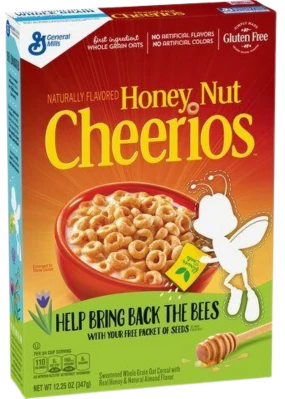
But Honey Nut Cheerios didn’t stop there. They have taken concrete steps to make a real difference. With each box of their cereal, the company has distributed an astounding 1.5 billion packets of bee-friendly flower seeds, encouraging people to plant them in their gardens and fields. This simple act has blossomed into a powerful movement, fostering environments that support bees and their vital pollination role.
It’s important to note that bees are not aggressive like their wasp counterparts. Unlike wasps, bees can only use their stingers once before sacrificing their lives. So, unless you provoke them, the chances of being stung are pretty slim.
Why all this effort to save the bees, you may wonder? Well, the answer is as clear as honey. Bees play a crucial role in pollinating countless plants, including the very fruits and vegetables that grace our plates. Without them, our ecosystems and food sources would be in grave peril. Honey Nut Cheerios deserves applause for utilizing its platform to bring awareness to this vital cause. Their commitment to preserving the buzzing heroes of our natural world is truly commendable.
So, the next time you pour yourself a bowl of Honey Nut Cheerios, remember that you are supporting a brand that is more than just delicious cereal. You are joining a movement, a collective effort to safeguard the remarkable honey bees and secure the future of our planet… or is it all an elaborate marketing campaign of greenwashing by a massive corporation?
Cinnamon Toast Crunch: The Curious Case of the Cinnamon Toast Crunch Bakers
Before Cinnamon Toast Crunch embraced its notorious crew of cannibalistic cinnamon squares, it had an entirely different cast of characters—three bakers who added a dash of whimsy to breakfast time, much like Rice Krispies’ iconic trio.
In 1985, just a year after the cereal’s launch, the company introduced three animated bakers, each responsible for singing a word of the cereal’s mouthwatering title. Among them, only one was bestowed with a name—Wendell. As the oldest of the bakers, Wendell charmed audiences and even continued to make appearances in future commercials.
But then, something peculiar happened in 1991—the other two bakers vanished from the advertisements, leaving only Wendell behind. This sudden disappearance sparked speculation and raised eyebrows among cereal enthusiasts. Rumors swirled, some more tongue-in-cheek than others, suggesting that Wendell’s jealousy got the best of him. The dark joke whispered of a cinnamon swirl river where the younger, more slender bakers met their untimely fate. Of course, the company swiftly debunked such fanciful notions, issuing a statement claiming that customer feedback had rendered the younger chefs unpopular. But who truly knows the untold secrets of the cereal world? Could they be covering for Wendell’s misdeeds?
The mystery surrounding the fate of the Cinnamon Toast Crunch bakers continues to pique the curiosity of cereal aficionados. While we may never uncover the truth behind their disappearance, one thing remains certain—Wendell, the last baker standing, carries the weight of this enigmatic history. His cinnamon-swirled journey has become an integral part of Cinnamon Toast Crunch lore, leaving us to ponder the fate of his long-lost companions.
So, as you savor a bowl of those delectable, cinnamon-sugar squares, take a moment to reflect on the bygone era of the Cinnamon Toast Crunch bakers. Their presence may have faded, but their enigma lingers, adding an extra sprinkle of intrigue to your breakfast routine. And who knows? Perhaps the secret lies within the cereal itself, waiting to be discovered by those with a taste for adventure and a hunger for the truth. Am I the only one who feels this sage may become the next, great, cold case podcast!
Frosted Flakes: Tony's Star-Studded Journey And A Cereal Sponsorship Extravaganza
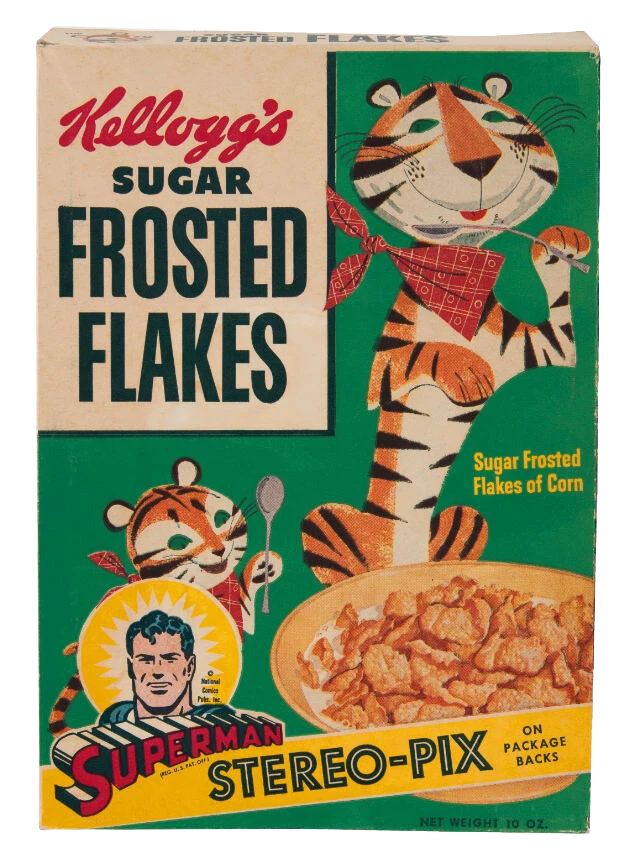
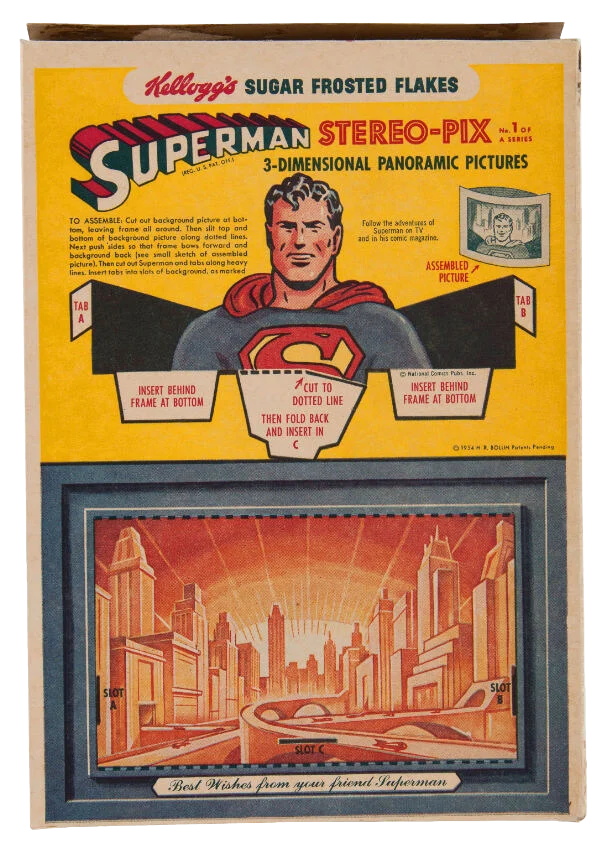
The 1954 Frosted Flakes Superman Stereo-Pix cereal box.
Tony the Tiger—the charismatic mascot who has graced our cereal boxes since 1952. Even if you’ve never savored a bowl of Frosted Flakes, you undoubtedly know his iconic catchphrase by heart. Tony’s charm has made him a staple in numerous sponsorships, including the current NHL Playoffs. But hold on, Tony’s star-studded journey doesn’t end there. Frosted Flakes has had the pleasure of partnering with some of the most beloved figures in popular culture.
Long before the era of cinematic superhero blockbusters, Superman captured the hearts of fans everywhere. And guess who made appearances alongside the Man of Steel in Frosted Flakes commercials? None other than George Reeves, the actor known for his portrayal of Superman in the iconic television show Adventures of Superman during the 1950s.
These classic commercials, many of which can be found on the first season’s DVD release, offered a delightful fusion of breakfast cheer and superhero excitement.
Fast-forward to the ’90s, a nostalgic era for many. This was a time when children were captivated by a purple dinosaur named Barney and Friends. If you were a ’90s kid, chances are you spent hours singing and dancing along with Barney’s cheerful tunes. And guess who lent a helping hand in bringing Barney’s world to life? Frosted Flakes!
Throughout the 1990s and into the mid-2000s, Frosted Flakes proudly sponsored both Barney and Friends and the delightful animated series Dragon Tales. Their generous financial backing played a significant role in bringing these beloved shows to our screens and into our hearts.
Thanks to Frosted Flakes’ support, we can now look back on those cherished childhood memories and reminisce about the joy and laughter they brought. The collaboration between Frosted Flakes and these iconic figures added an extra sprinkle of excitement to our mornings and helped shape the cultural landscape of our childhoods.
So, next time you pour yourself a bowl of Frosted Flakes, take a moment to appreciate the cereal’s star-studded history. From teaming up with the Man of Steel to supporting a purple dinosaur’s adventures, Frosted Flakes has always known how to make breakfast feel like a blockbuster event. Tony the Tiger and his cereal companions have left an indelible mark on both our breakfast routines and our fondest memories.
Lucky Charms: Pioneered The Marshmallow Revolution
Let’s talk about the real stars of the cereal world—marshmallows! We all know they are the ultimate delight in our favorite childhood cereals, adding a sugary and colorful touch. But did you know that Lucky Charms was the pioneer, leading the way with its charming marshmallow medley? That’s right, that mischievous little leprechaun blessed our breakfast bowls with marshmallows back in 1964.
The idea for Lucky Charms originated from a challenge to reinvent and enhance plain Cheerios. And what better way to elevate a classic cereal than by introducing marshmallows inspired by the enchanting concept of a charm bracelet?
The original Lucky Charms cereal boasted four distinct marshmallows: a yellow moon, a pink heart, an orange star, and a green clover. It was a stroke of genius that captivated cereal lovers around the world.
60 Years of Lucky Charms Boxes

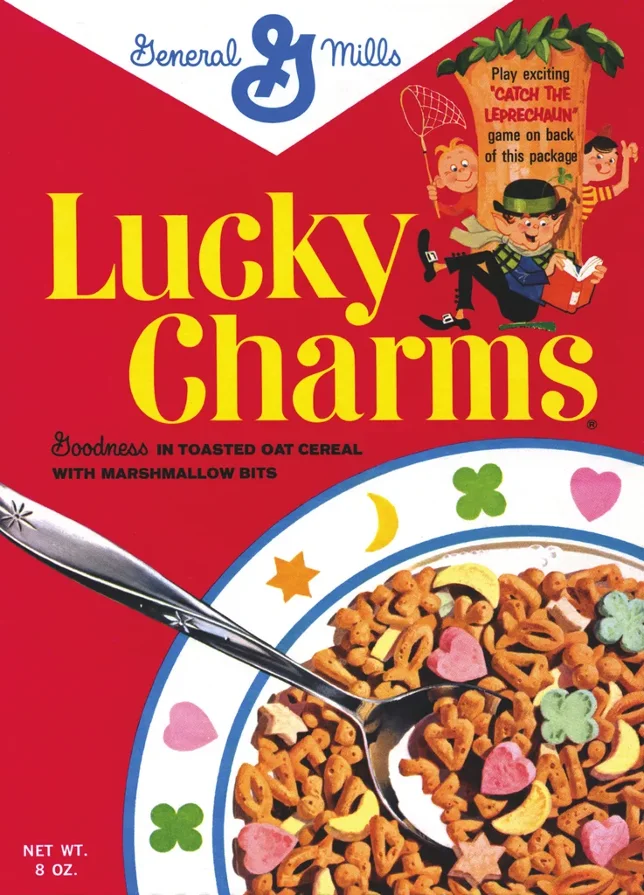

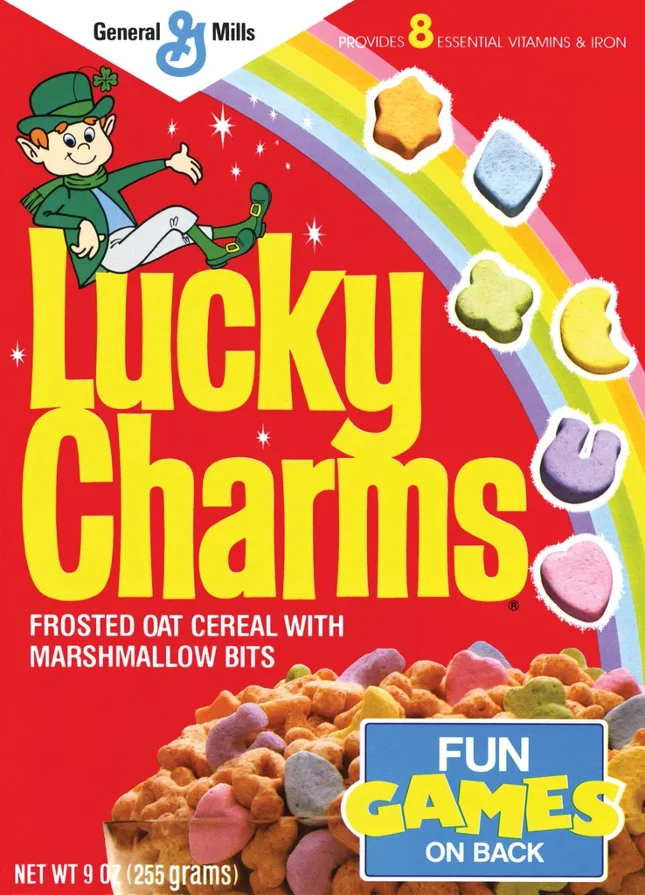
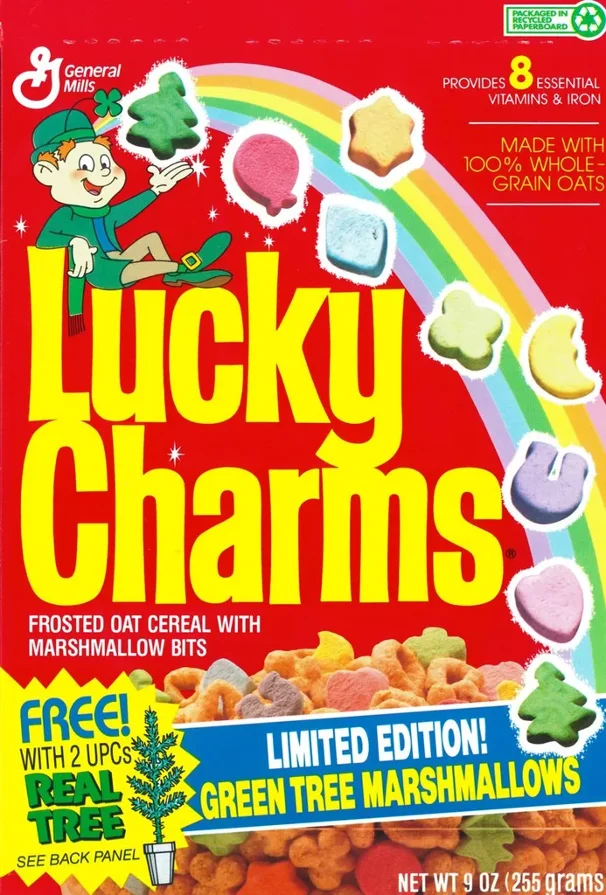
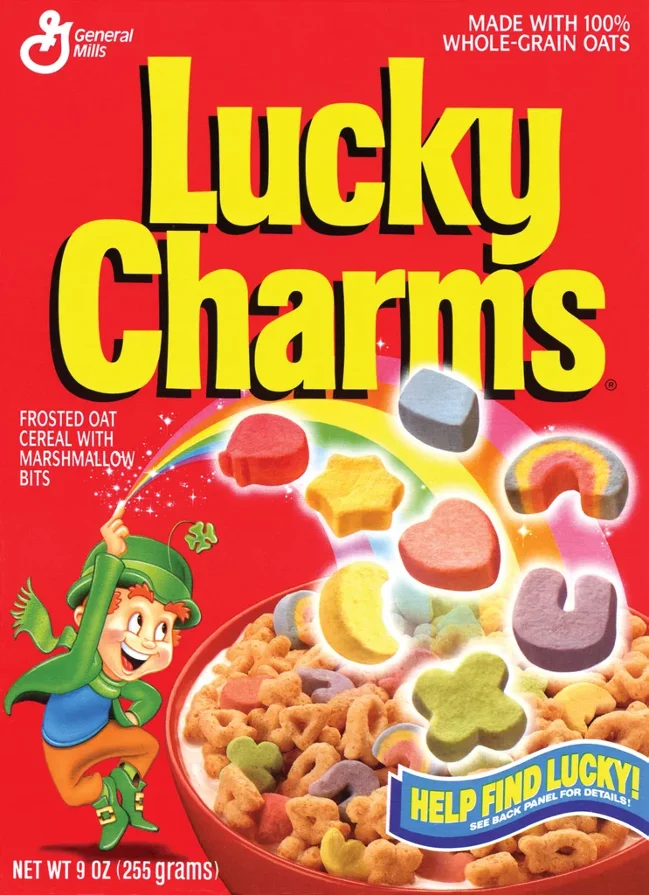
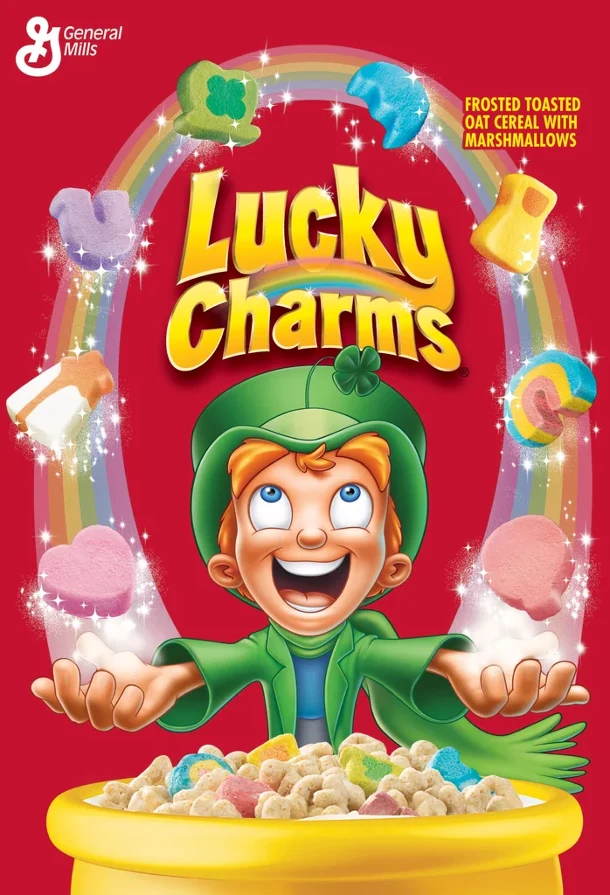
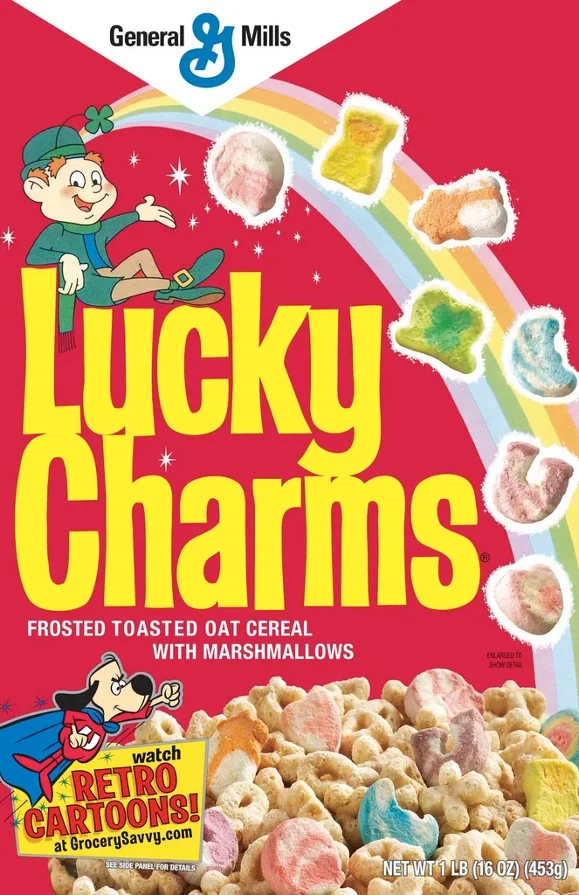
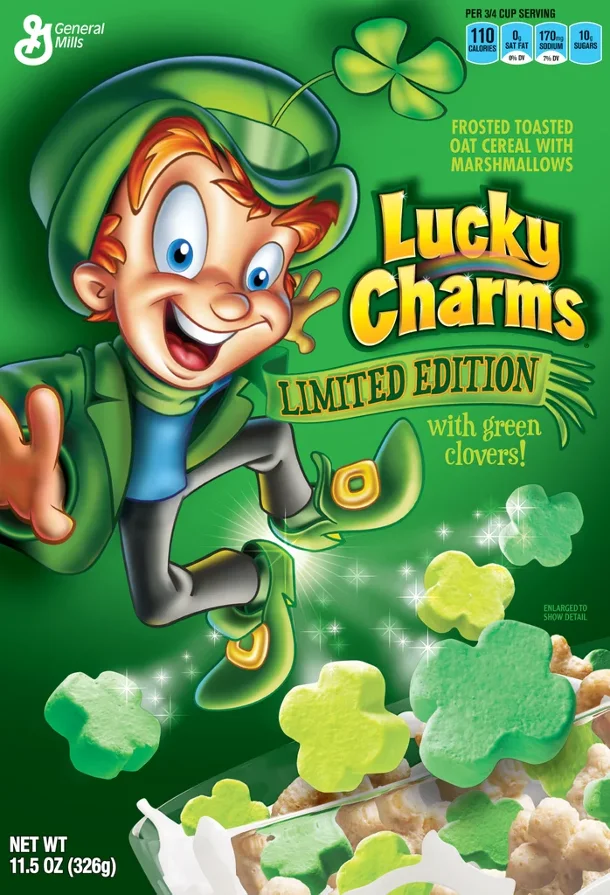
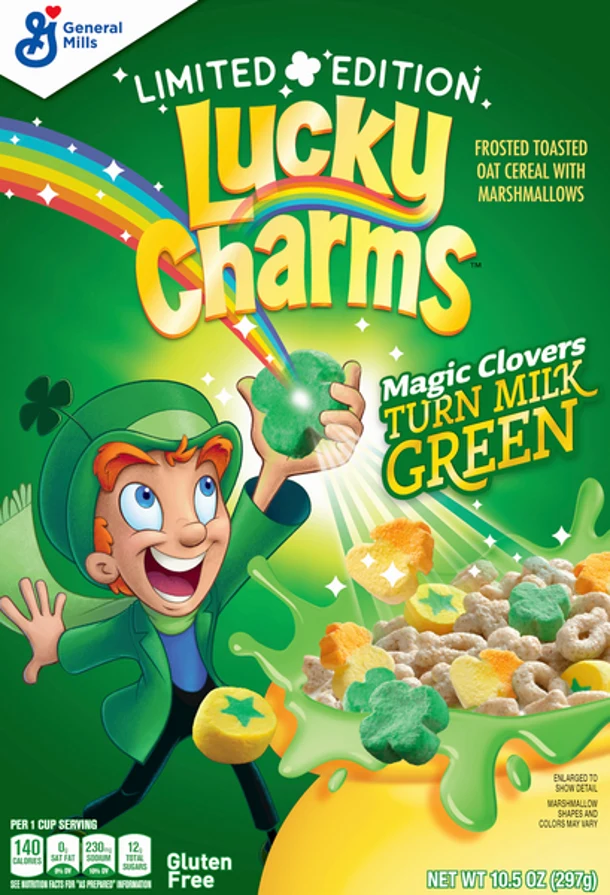
Over the years, the marshmallow lineup in Lucky Charms underwent some magical transformations. The yellow moons were the first to fade away, making room for newer marshmallow adventures. The clover and shooting star also underwent redesigns, adding a dash of freshness to the mix.
Today, Lucky Charms boasts eight enchanting marshmallow shapes, each with its own unique superpower. Picture a pink heart, a unicorn, a shooting star, a horseshoe, a green clover, a blue moon, a red balloon, and a rainbow—all magically coexisting in a bowl of delightful goodness.
These marshmallows bring an extra sprinkle of joy and wonder to every spoonful.
But wait, there’s more! Limited edition versions of Lucky Charms have surprised us over the years. One such special edition took the marshmallow game to new heights—the elusive and highly sought-after all-marshmallow version. Yes, you heard that right. It was a marshmallow extravaganza that left lucky cereal aficionados craving more.
So, the next time you pour yourself a bowl of Lucky Charms and revel in the delightful marshmallow morsels, remember the legacy behind those colorful charms. Lucky Charms revolutionized the cereal world, turning breakfast into a magical, sugar-laden and rather unhealthy, adventure.
Froot Loops: The Colorful Deception
Prepare for a mind-bending revelation: all those vibrant Froot Loops that you thought had distinct flavors actually taste the exact same! Yes, you heard it right. This cereal’s flavor deception is a prime example of the placebo effect in action. So, sit back and let’s dive into the world of fruity illusion.
But first, let’s address the misspelling. The reason for the “Fruit” in Froot Loops being spelled with two “o”s is not a typo—it’s a clever play on words. Contrary to what one might assume, these colorful loops contain no actual fruit. Instead, the vivid hues are achieved through artificial coloring, hence the absence of taste variation.
Now, here’s an interesting twist: the colors of Froot Loops in the UK differ due to EU guidelines that only permit natural coloring. Since there are limited natural options for coloring yellow, it was replaced with purple across much of Europe. Talk about a colorful compromise!
Although the marketing team had convinced us for decades that each color of Froot Loop had a unique taste, the truth quietly emerged in 1999. Researchers conducted blind taste tests and uncovered a shocking revelation—there is absolutely no difference in flavor among the vibrant loops. They all taste like a peculiar combination of sweetness and cardboard. Say it isn’t so!
The Kellogg company, unable to ignore the undeniable evidence, eventually had to come clean and acknowledge the awful, awful truth. So, the next time someone claims to dislike a particular color of Froot Loop, kindly remind them that it’s all in their head. The flavors are merely an elaborate charade, playing tricks on our taste buds and challenging our perception of reality.
Nesquik's Delicious Transformation From Powder to Cereal
Ah, Nesquik powder—the sweet delight that has tempted us all to pour way too much into our milk. But did you know that Nesquik’s journey began in powdered form before it transformed into the beloved cereal we know today?
Nesquik isn’t just the name of the cereal; it’s a versatile brand, encompassing a range of Nestlé products. From drink powder to breakfast bars and candy bars, Nesquik has tantalized taste buds in various forms. The drink powder made its debut in America way back in 1948, quickly capturing the hearts of people nationwide.
Many classrooms witnessed the energy surge of hyperactive children who had devoured generous bowls of Nesquik for breakfast. And chances are, they were likely to indulge in more of it for lunch in its powdered version. Ah, the sugar-fueled days of yore!
But it wasn’t until 1999 that Nesquik made its grand entrance into the cereal realm. Thanks to Cereal Partners, inspired by the likes of Cocoa Puffs (their most direct competition), the concept of Nesquik cereal was born.
Picture a wheat or whole grain cereal covered in chocolate that magically melts in the bowl, transforming milk into a scrumptious, and obviously super healthy (wink, wink), chocolatey delight.
It’s every kid’s dream breakfast, right?
Fast-forward to today, and Nesquik cereal has gained popularity in 43 countries, with its primary manufacturing hub located in France. As if the chocolatey goodness wasn’t enough, there’s even a white chocolate version for those seeking an extra twist of sweetness. But hold on, the story doesn’t end there.
The Nesquik powder that started it all still holds a special place in the hearts of chocolate enthusiasts worldwide.
In fact, it remains immensely popular and is available in a wide array of flavors, far exceeding the options offered by any other Nesquik product.
The Trix Bunny: A Tricky Tale on Two Wheels
We’ve all heard the famous phrase, “silly rabbit, Trix are for kids!” Even if you’ve never had a spoonful of the cereal, you’re undoubtedly familiar with the mischievous mascot himself—the silly bunny. Making his debut in the first Trix commercial back in 1959, this long-eared icon has been synonymous with the cereal ever since.
The concept behind the Trix Bunny is as playful as it gets. The bunny’s relentless pursuit revolves around finding children who possess a box of Trix cereal and attempting to trick them into surrendering a bowlful. However, in a classic case of comedic irony, each time the wily rabbit comes close to achieving his goal, he explodes with excitement, inadvertently giving himself away. This hilarious scenario draws inspiration from the Greek mythological figure King Sisyphus, who, as punishment for his deceitful tricks, was condemned to perpetually repeat a futile task that ended in failure. Oh, the irony!
The mischievous bunny’s popularity soared, prompting the cereal company to host two previous children’s contests. These contests rewarded participants with pins to vote on whether the Trix Bunny should finally taste the coveted cereal. The immense success and enthusiasm surrounding these contests laid the groundwork for an extraordinary event—the Tour de Trix Bicycle Race.
In 1991, our beloved Trix Bunny pedaled his way into the Tour de Trix Bicycle Race, cleverly named as a playful nod to the prestigious men’s bicycle race, the Tour de France. As the race reached its conclusion, confusion reigned among the judges regarding the bunny’s victory and whether he should claim the coveted prize. The resolution came in an unexpected manner—a democratic children’s vote. Overwhelmingly, the children decided that the Trix Bunny had earned his hard-earned prize.
Count Chocula Was Originally Part Of A Monster Series Among Cereals
For those who indulged in sugary morning delights, Count Chocula holds a special place in your heart. Launched in 1971, this chocolaty marshmallow cereal featured the charmingly muppet-looking character known as Count “Chocula”—an obvious play on the name Dracula. The cereal boasted delectable bat and ghost-shaped marshmallows that added a whimsical touch to breakfast.
But here’s a tidbit you might not recall—Count Chocula was part of a larger lineup of monster-themed products. These seasonal releases, timed perfectly around Halloween, captivated kids’ imaginations. Count Chocula, being the most popular variation, sometimes remained available for longer stretches of the year. The cereal’s immense success even sparked the creation of Betty Crocker fruit roll-ups and Count Chocula cereal bars, ensuring that the magic of Count Chocula could be enjoyed beyond the breakfast table. As if the cereal wasn’t enticing enough, the lineup also offered an array of cool prizes, including vinyl figures, posters, paint sets, cars, and more.
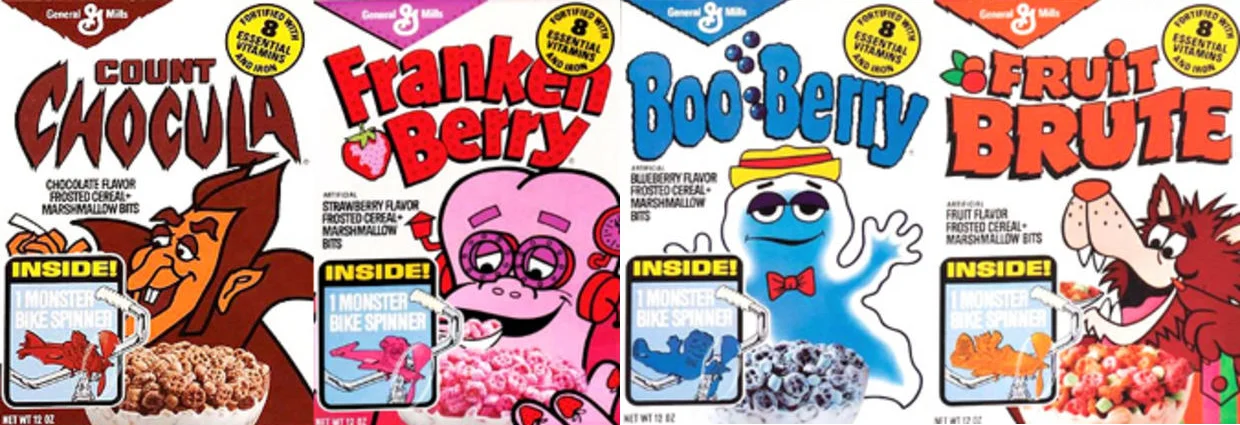
Originally, the monster series featured Count Chocula alongside Franken Berry. The two engaging characters would banter and playfully argue over who had the superior cereal in television commercials, with Count Chocula ultimately taking the spotlight. While both cereals were packed with sugar and lacked nutritional value, Franken Berry faced a setback due to an unusual side effect—turning children’s poop pink. As a result, the spotlight remained on Count Chocula as the reigning champion of sugary goodness.
The monster-themed series didn’t stop there. It also introduced Boo Berry, the ghost who claimed the title of the first-ever blueberry cereal. Additionally, there was Fruit Brute, the werewolf, and Yummy Mummy, the mummy, who replaced the werewolf before meeting their own demise. Sadly, the latter two characters were officially discontinued in 2014. However, fear not! Every Halloween, you can still find Boo Berry, Count Chocula, and Franken Berry gracing store shelves, continuing the tradition of spooky cereal delight.
Fans of comic illustration might recognize the art style of the more recent cereal versions, as they were masterfully crafted by the legendary Jim Lee. This blend of whimsy and artistry truly brings the world of Count Chocula and his monstrous companions to life, adding an extra layer of enchantment to every bite.
So, the next time you reminisce about indulging in the delightfully sweet Count Chocula cereal or find yourself humming the Trix Bunny’s catchy jingle, remember the stories behind these iconic characters. They’ve captured our hearts, ignited our imagination, and become beloved figures in the world of breakfast cereals.
Special K's Diet Controversy: Challenging Diets with a Pinch of Irony
Special K, the brand with a sassy take on unhealthy diets, found itself in the hot seat with its own diet campaign. The concept behind their initial Special K challenge was simple yet alluring—offering an easy and delicious way to shed those extra pounds in a healthy manner. But, alas, not everything went as smoothly as pouring milk over cereal.
As the campaign unfolded, the company faced a barrage of criticism and health-related controversies. One of the main points of contention was the claim that Special K contained a significant nutritional amount of iron. However, it was later revealed that the iron present in the cereal was of the metallic variety, far from suitable for the human body. Oops!
The premise of the challenge seemed promising: lose six pounds in just two weeks by consuming specific Special K products throughout the day. Each product, carefully formulated, contained a certain amount of sugar and skim milk to meet the purported daily value. But here’s the kicker—these products failed to provide lasting satiety or sufficient long-term nutrition.
Participants often found themselves feeling unsatisfied and battling hunger pangs throughout the day, ultimately succumbing to their cravings. To make matters worse, the challenge lacked comprehensive guidelines for curbing unhealthy eating habits, both in terms of overeating and undereating. Critics rightfully pointed out the absence of education regarding health and lifestyle changes that would normally accompany a diet program.
In fact, some skeptics went as far as stating that the Special K challenge was no more beneficial than other run-of-the-mill diets, and in some cases, even worse. The absence of exercise recommendations raised eyebrows, questioning the campaign’s holistic approach to wellness. Many argued that true health and sustainable weight loss require a well-rounded regimen, including regular physical activity.
Interestingly, the foundation of the diet was based on an experiment that suggested eating certain cereals could lead to weight loss around the hips and thighs for overweight individuals. However, the execution of the challenge failed to address the broader spectrum of health factors and lifestyle adjustments necessary for a successful transformation.
In retrospect, Special K’s attempt to revolutionize dieting fell short of expectations. While their take-that attitude towards unhealthy diets was commendable, the execution didn’t live up to the hype. The controversy surrounding their health claims and the lack of sustainable nutrition left a bitter aftertaste for many consumers.
Lessons learned? A balanced approach to health and weight management is key. So, as you pour your morning cereal, remember that it’s just one ingredient in the recipe for a healthier lifestyle.
French Toast Crunch: Resurrected by Fan Demand Before Hashtags or Google
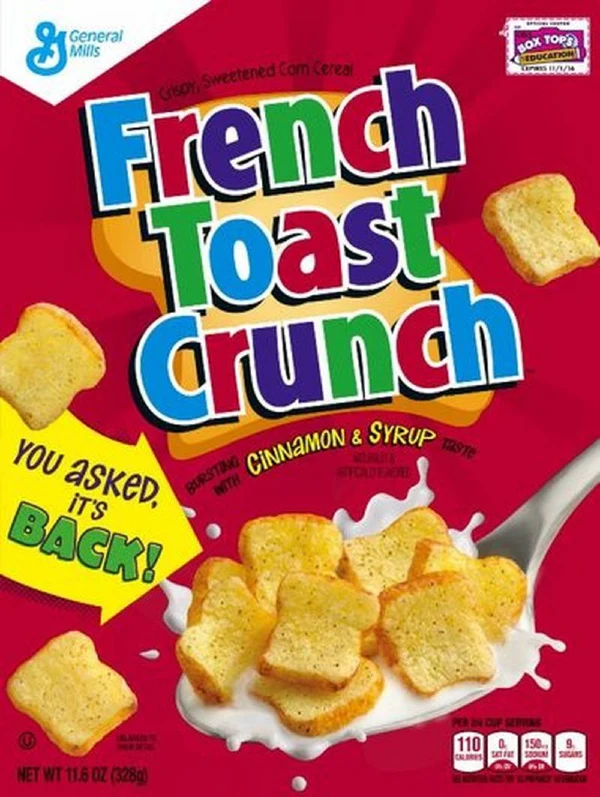
Did you know that French Toast Crunch, that scrumptious spin-off cereal of Cinnamon Toast Crunch, owes its triumphant return to the unwavering support of its fans? This delightful breakfast treat made its debut in 1995, capturing the hearts and taste buds of cereal enthusiasts everywhere.
French Toast Crunch boasted a natural flavor reminiscent of freshly made French toast, complete with its iconic little toast-shaped cereal pieces. These miniature delights underwent a transformation over time, evolving to resemble the familiar cinnamon-covered squares of its sister cereal, Cinnamon Toast Crunch. To emphasize the connection between the two cereals, the back of the box even featured Wendell, the beloved Cinnamon Toast Crunch baker, demonstrating how he skillfully “created” this mini French toast-flavored cereal.
Unfortunately, the joy of French Toast Crunch came to an abrupt halt in 2006 when it was discontinued in the United States, leaving devoted American fans yearning for their beloved breakfast staple. However, while American lovers were left feeling pained, our neighbors to the north in Canada and down under in Australia continued to enjoy the delightful cereal on their grocery store shelves.
Yet, the passionate French Toast Crunch enthusiasts were not ones to be defeated. They transformed their pain into protest, making their voices heard loud and clear. The outcry from these die-hard “French toasters” reached the ears of the cereal company, and to the delight of breakfast lovers everywhere, their pleas were answered. In 2014, the company announced that French Toast Crunch would make its grand return to American breakfast tables by the end of 2015.
The news was met with overwhelming joy and gratitude from fans who had eagerly awaited the cereal’s comeback. People celebrated the company’s decision, showering praise upon them for listening to their loyal and passionate supporters. Even the CEO took to social media, expressing heartfelt appreciation to the fans for their unwavering dedication to the product.
The relaunch of French Toast Crunch not only marked its triumphant return, but it also brought back the original toast-shaped cereal pieces that had captured the imaginations and taste buds of fans years before.
That’s all folks!
And there you have it, the complete collection of untold truths about your favorite cereals. From bee-saving missions to magical marshmallows and triumphs of persistence, these cereal secrets add an extra sprinkle of delight to your breakfast routine. So, next time you pour yourself a bowl of your childhood favorite, savor the taste while remembering the quirky stories behind each spoonful. Breakfast just got a whole lot more fun and fascinating!




















